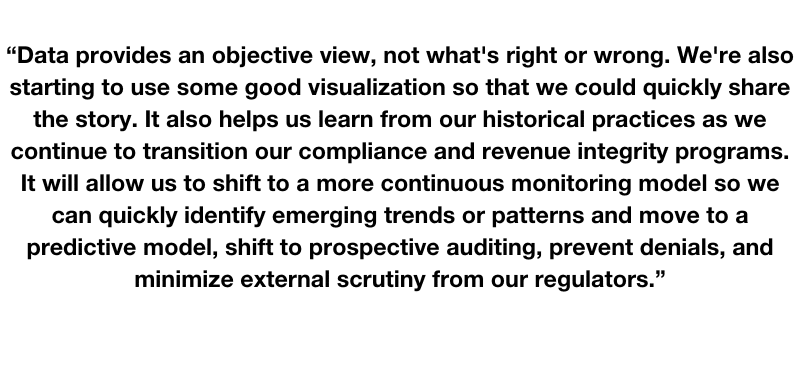Each year, MDaudit gathers with its customers at a compelling, educational event that reveals deep and meaningful insights from its users. We have gathered these prized pieces of useful and tactical information for you to learn from and take back to your organization.
In an open roundtable discussion about revenue integrity and how it applies to their organizations as it relates to today’s increasingly challenging reimbursement landscape, MDaudit customers shared many strategic insights.
The discussion centered on how strategic alignment between various departments (billing compliance, coding/HIM, and revenue integrity) drives optimal reimbursement, maintains compliance, and creates operational efficiency.
A key theme throughout the discussion focused on how impactful revenue integrity functions extend beyond traditional means of reporting and training, and delved into the strategies being used by our customers to drive more successful outcomes.
With many looming threats to their revenue stream, customers opened up about their strategies to mitigate:
- 2023 E&M changes
- Increased scrutiny on specialty/designer drugs
- HHS massive budget increase for fraud, waste, and abuse
- Telehealth scrutiny is not going away
- Getting caught up on COVID-19 coding changes
- The constantly evolving landscape of regulations
- Government and commercial payers arming themselves with AI and ML
HEAR FROM THE SOME OF THE TOP IDNs IN THE COUNTRY
QUESTION 1: How do you define revenue integrity within your organization and what are some of the key focus areas for the function?
“We don’t have a formal program running, however, at the start of this calendar year, we (compliance) started to meet regularly with revenue cycle and our coding department to work together. We span so many different entities and having an area where we come together and share efforts and recognize what’s going on and create standards that we can carry through is so important. We’re definitely in the building stages, but we have already seen so much value in the time that we’ve spent collaborating intentionally; we now meet every other week.”
“We have a revenue integrity program that’s about a year old now that was established to prevent issues that cause repeated leakage and compliance risk through effective, efficient, and repeatable processes and internal controls. The program was ultimately adopted from NAHRI. Our key focus area is learning and assuring we have all of our workflows built correctly so that we can capture all of that revenue.”
QUESTION 2: What kind of metrics are you using to measure success and communicate value across the organization?
“Our measures right now are primarily tied directly to the revenue cycle with our key tool being our daily reconciliation report. We are keenly in tune with the daily charge, reconciliation, and monitoring what was denied, and what got stopped in the coding work queues with edits. We’re also monitoring claim acceptance rates and looking at trend lines, hoping they begin to go down and level out. We also look at clean claims and claim summaries. But the most important and real value to leadership is showing that we’re managing leakage and ensuring charge capture at the front end. We’ve had a significant shift in charges that are now being captured on the front end of the revenue cycle by our clinical team, the folks who are on the front line.”
“From a compliance perspective, we focus a lot on the audits we do, and so we share that information. We pay attention to the financial impacts and then present that information to the leaders across our health system. We also use the regulations that come out to forecast the areas that we identify as the biggest areas of risk.”
QUESTION 3: Let’s talk about your organizational structure and the collaboration that must happen across departments.
“We have a one-voice initiative where we have revenue cycle, compliance, and revenue integrity folks. We are continually talking and in the center of that triangle are our providers. So, we need to continuously be hearing input from them around workflows that work and recommendations to create additional efficiencies as well as capturing accurate charges on the front end. The compliance program talks with our revenue integrity colleagues on a daily basis. We’re in constant communication, learning from one another and then adjusting workflows, as may be needed.”
“Typically, we meet monthly. But certainly, as new things come up, the meeting gets thrown out and we’re all brought together to talk through either the issue at hand or the new service that’s being requested.”
QUESTION 4: What are some of the challenges in executing your revenue integrity agenda across the organization?
“The challenge today is making sure we want to do it right on the front end, and that the folks that are capturing these charges at the very front end of the revenue cycle have the appropriate training and the appropriate support. We’re also continuing to push for consistency in our overall approach, which is also a challenge.”
Our challenges include resources and staffing. In terms of resources, our EMR, Epic, can sometimes be overwhelming in terms of finding the report you need. Getting it set up the way you want so as to pull the data you’re looking for is tough. That’s where an analyst really becomes helpful in understanding not just what the request is, but delivering on it with the right type of information that can then be interpreted by leadership. I think that as healthcare has grown, we all have staffing issues to maintain that growth, and so I know our own revenue Integrity team is hoping that they’ll be able to add to their staffing this year to better support the needs that are requested.”
QUESTION 5: What role can data and analytics play to drive revenue integrity outcomes?
“Without MDaudit, our work would be nearly impossible. To have all the data in one place where we can report out in several different ways is extremely valuable. It helps to set up and identify areas of focus and what to share to continue to get buy-in by showing how valuable it is.”
“I can’t think of any area where data and analytics aren’t important nowadays. We use MDaudit as much on the revenue integrity side as we do on the auditing side. It’s key when you’re putting a new service in place to make sure that charges are going out as expected. In addition, there are concerns that are brought forward by other departments that you can’t answer unless you dig down through the right data.”

QUESTION 6: How can you leverage MDaudit to drive the three pillars of revenue integrity: optimal reimbursement, compliance, and operational efficiency?
“Those three pillars really ring true in terms of optimal reimbursement. Are we capturing every service compliantly based on payer and coding guidelines? And regarding the operational efficiency piece, it’s really about automation, and MDaudit helps to support that in terms of the number of reports that require very little in terms of putting in parameters to have them pull accurately. Then once you’ve saved it you can rely on it time and time again and your work scales as you use the platform.”
“It’s the data that’s going to help drive our business and has also helped us create discipline around using the tools. Going in regularly and examining the risk areas helps prioritize our work, and then ultimately creates some discipline into regularly shifting as we need to focus on those highest priority risks for the organization.”
QUESTION 7: Do you have any final thoughts for any of the leaders listening to this panel in setting up the revenue integrity function to be successful?
“Have accountability, consistency, standardization, and repeatability to launch the program. I can’t stress that enough. The second most important thing is having buy-in and support from executive leadership. My last comment is data, data, data. Real-time data, time-sensitive data, data to back up the work that we’re doing, and data to help us become more effective in our roles and ultimately make the necessary changes to support our clinicians and deliver the highest quality care.”
“The recommendations from our revenue integrity team include really knowing and understanding your EMR and how it operates, being comfortable teaching and educating your providers, and then, lastly, having that proper reconciliation in place. Review and monitor on a regular basis which to me really ties in with standardization”
From these enlightening customer perspectives, learn that:
- Automation is key to achieving operational efficiency
- Data is paramount in deducing a multitude of strategies and tactics to:
- Report accurately
- Drive business decisions
- Support clinicians
- Greatly reduce denials
- Get on the same page throughout the organization
- The various definitions of revenue integrity all have common goals: to boost the organization’s bottom line, become as compliant as possible, and work together across departments
- There are challenges across the healthcare landscape that the right technology can help solve
Talk to an MDaudit specialist about how you can achieve optimal reimbursement, compliance, and operational efficiency with the right technology.





